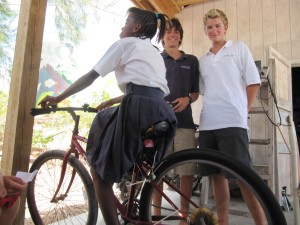by Jon Vredenburg
The purpose of our project was to raise awareness about energy consumption. At The Island School, we have spent many community meetings talking about water conservation. Yet not as much concern is shared with electricity conservation. 80% of our power comes from our solar panels and wind turbine, which is great, but that means that 20 % of our electricity is still being generated at the diesel power plant in Rock Sound.
For the last month, Nic and I have been in the process of building a pedal powered generator. When we were in the open space technology brainstorming session, we were both passionate about raising awareness about energy consumption. We wanted students and faculty alike to be able to pedal a bicycle and watch as the power they produce makes them a smoothie. After some research, we realized that powering a blender would require an AC inverter that could cost up to two hundred dollars on its own. Our design uses an old bicycle frame mounted on a steel stand. During the initial planning stages, we researched other builder’s designs, materials, and costs. Right away we seemed to have found a major problem. Nearly every design would us cost 500 dollars or more!
We set out to use parts salvaged from the resource center and the Deep Creek dump. We would have never been able to complete our project without help from the facilities staff. Marco, Cap, Rico and Joseph were all pivotal to the success of our project. We went through three different bikes until we found one we thought would work. We started off with an old yet functional mountain bike, but the day after we put pedals on it, it was reclaimed by its previous owner. We briefly tested our project advisor Jonny’s road bike, but quickly realized that the fixture may be semi-permanent. We settled on an old trek 800 hybrid bicycle. With Rico’s expert guidance, Nic dismantled the de-railler, unsheathed the shifters, and broke off the brakes. This bike needed no fancy foray of adjustable parts, we needed reliable and constant rpms for our tests.
The next step was to build the stand. A quick trip to the resource center proved to be productive. We found a piece of metal that seemed at first glance like it could have been a bicycle stand. After some fiddling around, we knew that it would take a few adjustments to get the bike to seat properly. With help from Cap, we cut pieces of steel L-bar from old scaffolding and mounted them to our base with some bolts. We now had a stationary bicycle worthy of a Lance Armstrong caliber workout, made entirely of salvaged parts with the exception of four zip ties.
The whole point of all of this building is to attach the generator. The problem was that we couldn’t find a generator that produces more than 1 volt. We tried to use a Chrysler 12-Volt DC alternator, but without a battery for exciting the generator we could not produce current. We also tested a motor from some sort of water pump, but we could only get about one volt out of it. This was not quite enough power to illuminate a Christmas light. With just a few hours of work time left, and no brightly burning bulb, we were desperate.
It was at that time that Marco decides to come take a look at our project. He says “this is no problem!” He left us to go look for a better generator, and came back about half an hour later with several small radio control car motors. The instant we tested the voltage on our new motor, we got a reading on the voltammeter of about 9 volts. The bulb that we attached glowed even at a lowRPM. Our project was successful. As Marco put it, we were “creating power from desire.”

